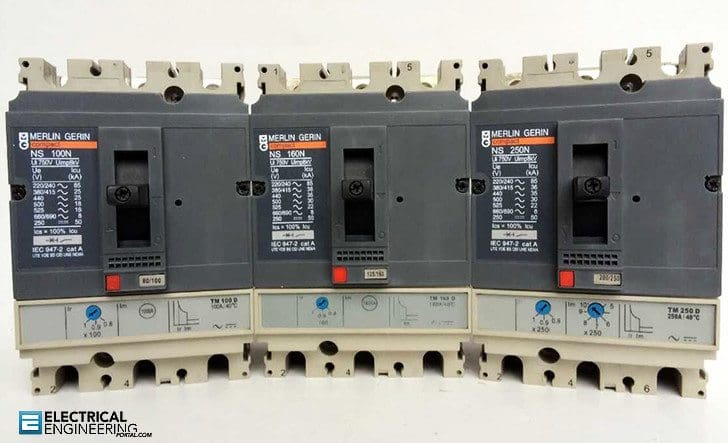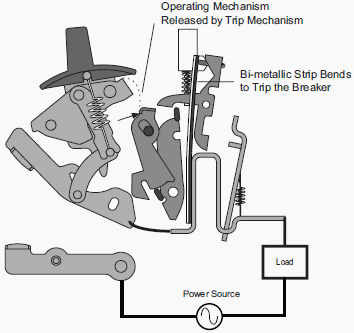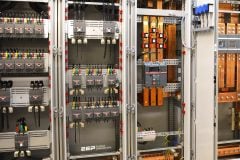Molded Case Circuit Breakers (MCCB)
Molded case circuit breakers are interrupting devices with self-contained, current-responsive elements. These breakers are assembled as an integral unit in a supported and enclosed housing of insulating material.

Depending on the amount of protection required, these breakers can sense internally and then clear undervoltage, overcurrent, and short circuit conditions.
Some tripping elements are also externally accessible through control wiring, and other circuit protection can be added. Breakers may rely solely on outside information to perform their prime function. Several trip units may be available for a particular frame size. A specific assembled breaker may have a lower continuous current rating than the current designation of the frame manufacturers.
Contacts often begin to part during the first cycle of a fault. The current breaker must be capable of interrupting the maximum allowable first-cycle asymmetrical current. The operating mechanism provides a means of opening and closing the toggle mechanism of quick-make/quick-break type contacts (snap open or closed independent of the speed of handle movement).
NOTE // The breaker is trip free and cannot be prevented from tripping by holding the breaker handle in the “on” position during a fault condition.


Molded case circuit breakers use is restricted to low voltage and medium voltage systems.
With alternating current (AC), this breaker provides high interrupting capacity for short circuits in minimum space. On AC or direct current (DC) systems, this breaker is often the first protection device to handle electrical problems.
MCCB Trip elements
Trip elements trip the operating mechanism of a circuit breaker during either a prolonged overload or a short circuit current. Some molded case circuit breakers have a screwdriver slot located on the front of the trip unit used for adjusting sensitivity.
The maximum setting is established by protection of the minimum conductor size in the circuit.
Instantaneous Magnetic Trip
Magnetic trips work by using an electromagnet in series with the load current. When the current reaches the set point, the electromagnet instantaneously trips. This type of trip is commonly found in low voltage breakers (e.g., household circuit breakers).
Thermal Trip
Considered the industry standard, these trip elements work using a bimetal heated by the load current. When overheated, indicating an overload, the bimetal will detect, which causes the operating mechanism to trip.


Thermal Magnetic Trip
A thermal magnetic trip, in addition to providing short circuit protection, guards against long-term current overloads existing longer than roughly 10 seconds. Because bimetal de ection is dependent on current and time, the thermal unit provides long-time delay for light overloads and fast response for heavy overloads.
The thermal magnetic unit may be ambient-temperature sensitive (breaker trips at a lower current as ambient temperature rises).
The National Electrical Code (NEC) defines the current at which a long-time-delay thermal element must initiate circuit-clearing operation. The NEC specifies a point that is 125% of the rated equipment or conductor ampacity.


The circuit breaker will take no action below this current. For conventional (non-compensating) thermal magnetic elements, the thermal portion defines the continuous current rating of the breaker (specified as 100% at 40°C). The thermal element current rating cannot exceed the frame rating.
Electronic Trip
Current transformers and solid-state circuits are used to monitor the current. When an overload or short circuit is detected, the monitors initiate a trip. Electronic trip elements can include trip features and exibility not present in other types of trip elements (e.g., adjustable pickup, time delays, instantaneous pickup, selective interlocking).
Solid-state components have replaced electromechanical-magnetic and thermal magnetic trip elements in some molded-case breakers.


Shunt Trips
A shunt trip relay completes the circuit between the control-power source and the solenoid coil. Shunt trips are used to trip a circuit breaker electrically from a remote location and consist of a momentary-rated solenoid tripping device mounted inside a molded case.
The shunt trip can remotely trip the breaker, but cannot remotely reclose the breaker. To reclose the breaker, the breaker handle must first be moved to the reset position and then to the “on” position.
Reference // Electrical Safety: Systems, Sustainability, and Stewardship by Martha J. Boss (Purchase paperback![]()











Dear Sir,
Hope u r well
For current limiting circuit breakers, does it come with Direct Acting (Series trip) modules
Thank you so much and best regards
Hello!
What difference between: Moulded case circuit breaker 50A and 3-phase miniature circuit breaker 50A ?
Thanks!
we are contacting you from ethiopian airlines procurement office. we would like to purchase different types of MCCB. Kindly send us your email address and we will send our requirement.